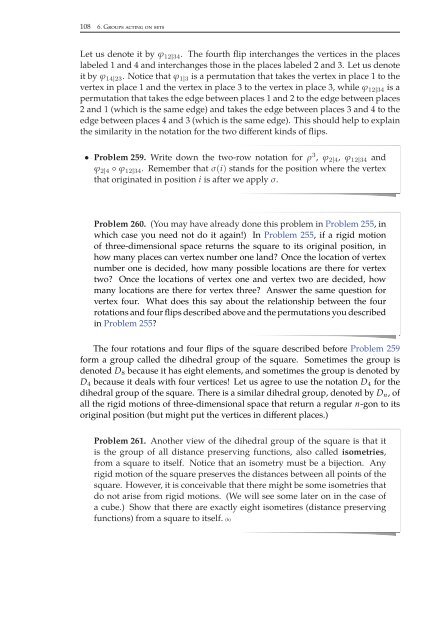Combinatorics Through Guided Discovery, 2004a
Combinatorics Through Guided Discovery, 2004a
Combinatorics Through Guided Discovery, 2004a
Create successful ePaper yourself
Turn your PDF publications into a flip-book with our unique Google optimized e-Paper software.
108 6. Groups acting on sets<br />
Let us denote it by ϕ 12|34 . The fourth flip interchanges the vertices in the places<br />
labeled 1 and 4 and interchanges those in the places labeled 2 and 3. Let us denote<br />
it by ϕ 14|23 . Notice that ϕ 1|3 is a permutation that takes the vertex in place 1 to the<br />
vertex in place 1 and the vertex in place 3 to the vertex in place 3, while ϕ 12|34 is a<br />
permutation that takes the edge between places 1 and 2 to the edge between places<br />
2 and 1 (which is the same edge) and takes the edge between places 3 and 4 to the<br />
edge between places 4 and 3 (which is the same edge). This should help to explain<br />
the similarity in the notation for the two different kinds of flips.<br />
• Problem 259. Write down the two-row notation for ρ 3 , ϕ 2|4 , ϕ 12|34 and<br />
ϕ 2|4 ◦ ϕ 12|34 . Remember that σ(i) stands for the position where the vertex<br />
that originated in position i is after we apply σ.<br />
Problem 260. (You may have already done this problem in Problem 255,in<br />
which case you need not do it again!) In Problem 255, if a rigid motion<br />
of three-dimensional space returns the square to its original position, in<br />
how many places can vertex number one land? Once the location of vertex<br />
number one is decided, how many possible locations are there for vertex<br />
two? Once the locations of vertex one and vertex two are decided, how<br />
many locations are there for vertex three? Answer the same question for<br />
vertex four. What does this say about the relationship between the four<br />
rotations and four flips described above and the permutations you described<br />
in Problem 255?<br />
The four rotations and four flips of the square described before Problem 259<br />
form a group called the dihedral group of the square. Sometimes the group is<br />
denoted D 8 because it has eight elements, and sometimes the group is denoted by<br />
D 4 because it deals with four vertices! Let us agree to use the notation D 4 for the<br />
dihedral group of the square. There is a similar dihedral group, denoted by D n ,of<br />
all the rigid motions of three-dimensional space that return a regular n-gon to its<br />
original position (but might put the vertices in different places.)<br />
Problem 261. Another view of the dihedral group of the square is that it<br />
is the group of all distance preserving functions, also called isometries,<br />
from a square to itself. Notice that an isometry must be a bijection. Any<br />
rigid motion of the square preserves the distances between all points of the<br />
square. However, it is conceivable that there might be some isometries that<br />
do not arise from rigid motions. (We will see some later on in the case of<br />
a cube.) Show that there are exactly eight isometires (distance preserving<br />
functions) from a square to itself. (h)


















